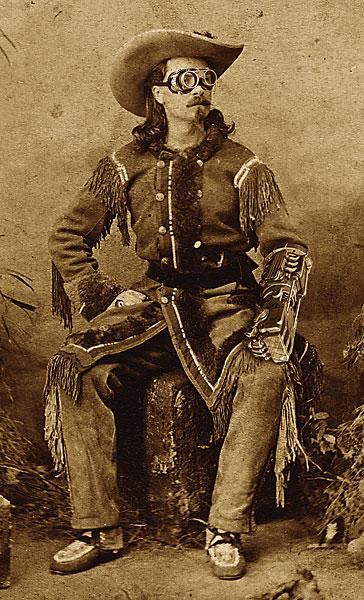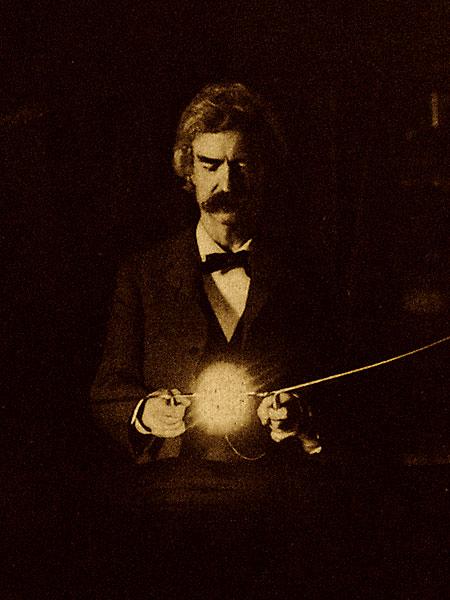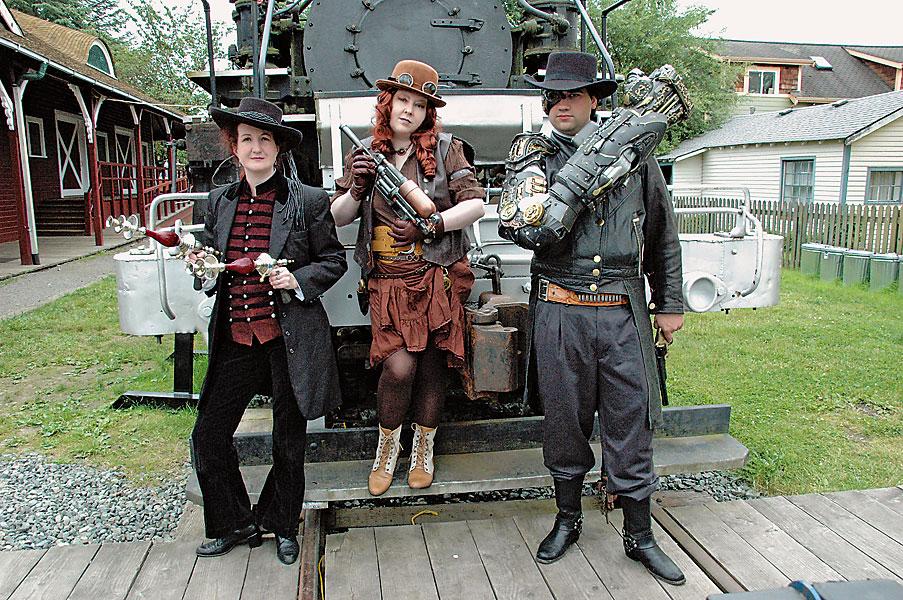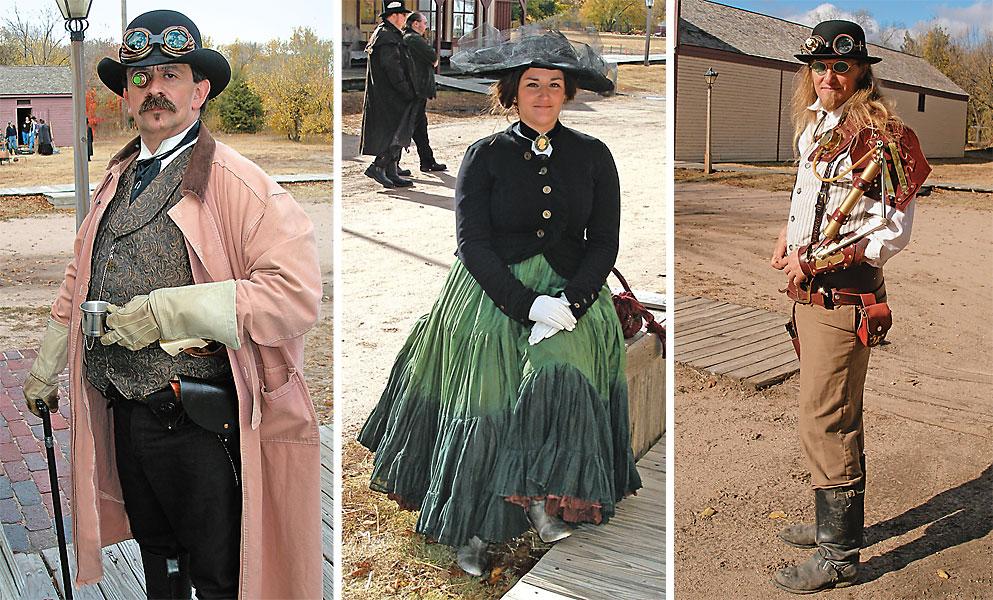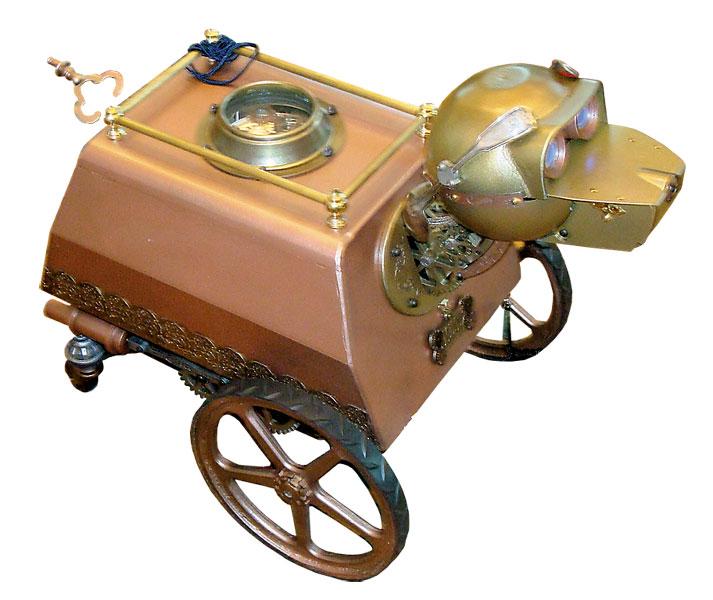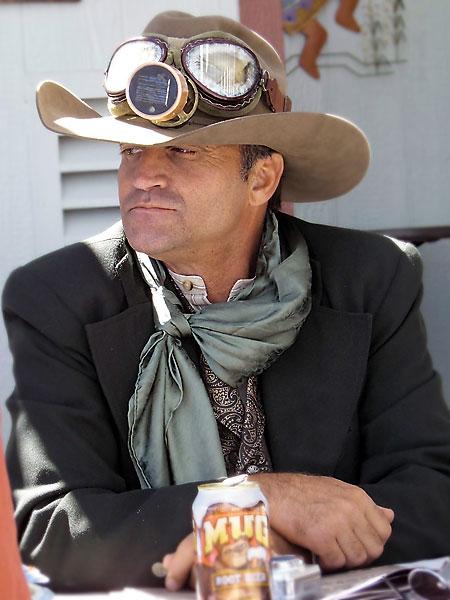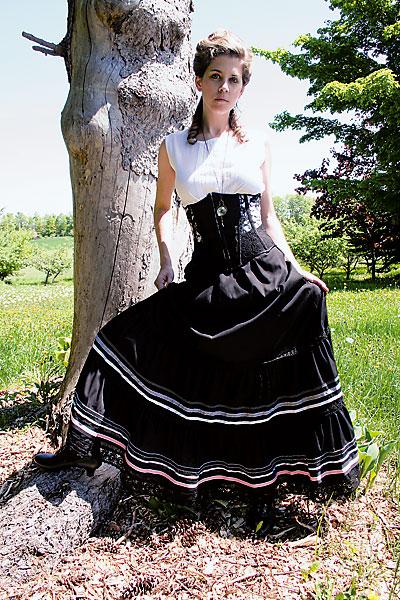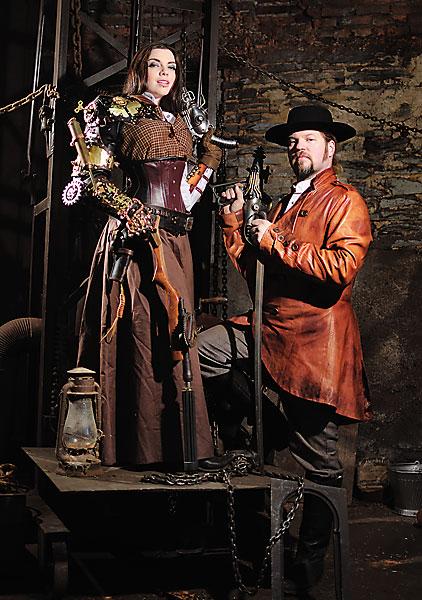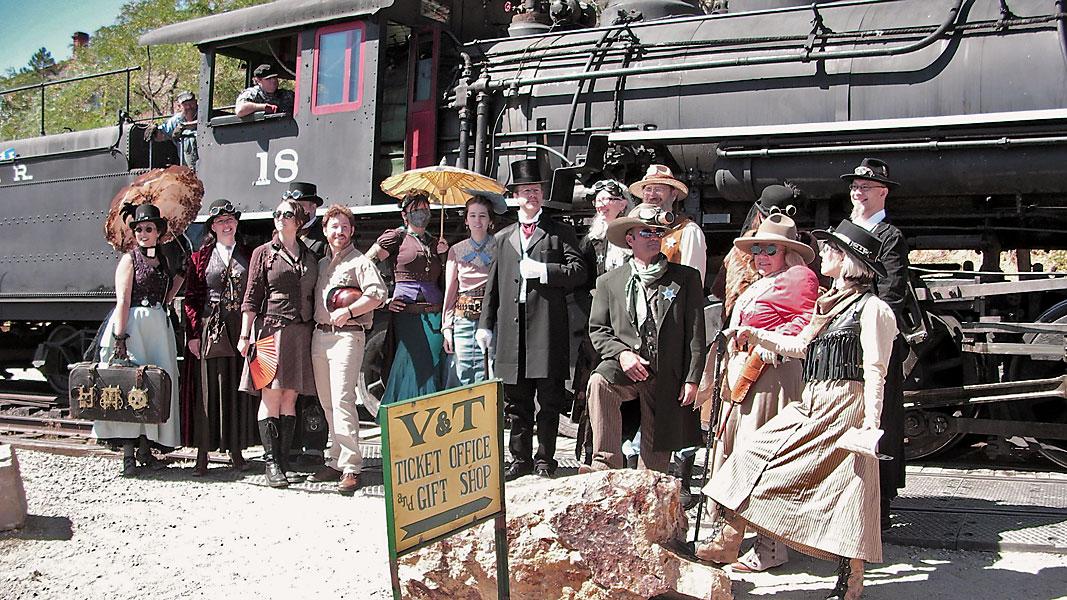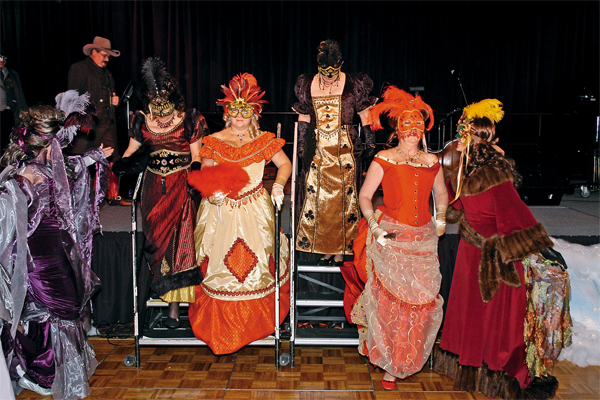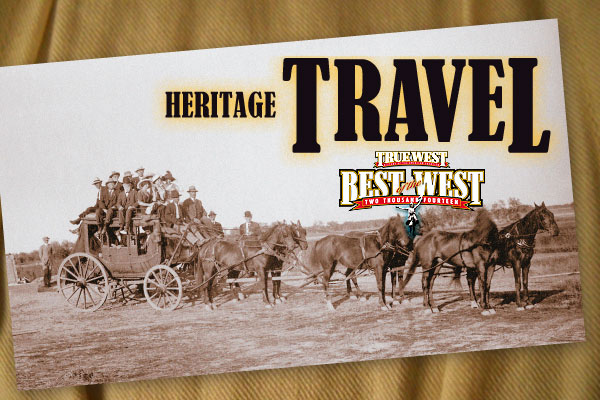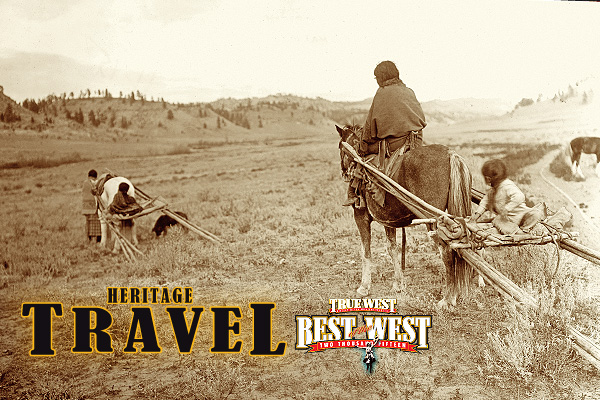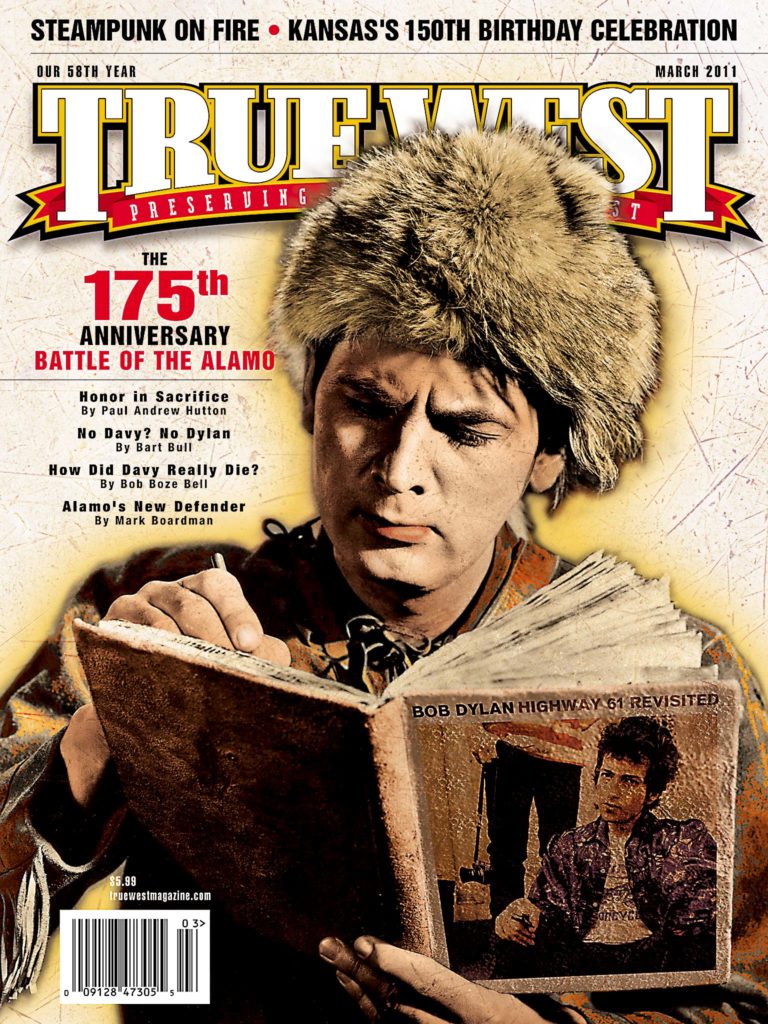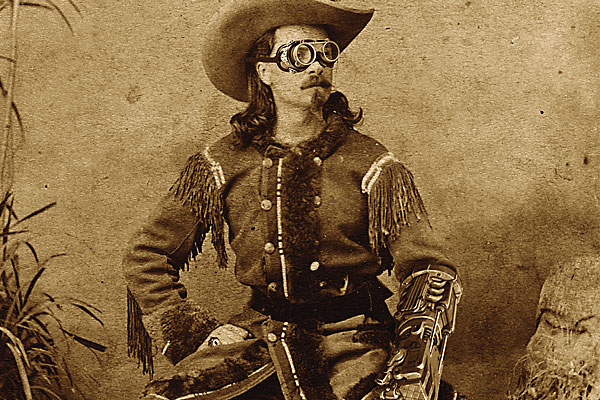
Steve Hauff, was the only man in the room of Steampunk enthusiasts not dressed in funkified Victorian garb
With his degree in Victorian history, history and physics, Thomas Willeford found a new hobby in blackpowder shooting and he became a cowboy action shooter with SASS’s West Shore Posse in Harrisburg, Pennsylvania, from 1999-2001. “I didn’t have the best shot,” he admits, “but I would show up in a different costume every time.”
His love of the Victorian-era period clothing got him interested in Steampunk, and since he was not the best shootist in the end, he shifted gears and became a purveyor of handmade corsetry, leather goods and other Steampunk accessories at Brute Force Studios. He recently dressed a character for a Steampunk episode of ABC’s Castle.
When asked what he thinks cowboy action shootists and Steampunkers have in common, Willeford responds, “They want to live in adventure…. People who like to role play will find any excuse to do it as much as possible.”
Steampunk … Say What?
Steve Hauff, noted train historian and author, was the only man in the room of Steampunk enthusiasts not dressed in funkified Victorian garb, but you could tell from his authoritative voice that he loved to share the history of the steam locomotive. This transportation phenomenon that tamed the vast distances of the Old West frontier was finding a new and admiring audience at the “Weird, Weird West” Steamcon convention in November 2010.
The growing cultural phenomenon of Steampunk that attracted 2,000 participants to Seattle, Washington, is often described as “Victorian Science Fiction,” but that sound bite does not truly capture these Steam Age enthusiasts. Steampunk embraces not only its own literary and dramatic genre, but it also has become a style of dress, an aesthetic movement and even a type of music.
Though Steampunk is often associated with the Science Fiction novels of H.G. Wells and Jules Verne, the name itself evolved as a joking play on words by fantasy author K.W. Jeter, who suggested, in a letter to Locus magazine in 1987, that the speculative Historical Fiction he and some of his fellow Science Fiction authors were writing should be labeled “Steampunk,” in contrast to the popular “Cyberpunk” novels of William Gibson and Bruce Sterling. Cyberpunk stories typically take place in a dystopian future. Steampunk novels, in contrast, are more often set in a re-imagined, steam-driven 19th century in which all manner of fantastic inventions are posited to exist and technology, in the grand tradition of the Victorians, is viewed as an exciting and positive hope for the future.
Gibson and Sterling even went on to contribute their own entry into Steampunk literature in 1990 with The Difference Engine. The book is set in an alternate 1850s London in which Charles Babbage’s mechanical computer becomes a functioning reality and dramatically changes the British industrial revolution.
Mike Perschon, a college English instructor and doctoral candidate who is writing his dissertation on Steampunk literature, defines Steampunk as an applied aesthetic to be found in a wide array of expression, be it film, costuming, art, gaming or home décor.
His website, the Steampunk Scholar, breaks down the essential elements of this aesthetic to include: “neo-Victorian”—drawing from the time period of roughly 1839 to the beginning of WWI; “retrofuturistic”—how the Victorians saw their own future; and “technofantasy”—anachronistic technology, either ahead of its own time or not yet possible.
So, in essence, Steampunk has no “punk,” but the term rolls off the tongue a lot quicker than, say, “Neo-Victorian, retro-futurist technofantasy.”
Wild Wild West
Though some purists claim that a Victorian London setting is key to the genre, one of the best examples of the essential Steampunk conceit—anachronistic technology in a 19th-century milieu—is set in the Old West.
The 1960s TV series, The Wild Wild West, stars Robert Conrad as Secret Service Agent James West, with Ross Martin as Artemus Gordon, his inventor-sidekick. Conceived as “James Bond on horseback,” the show features these two agents traveling the 1870s West in an elegant train car to fight crime and to protect President Ulysses S. Grant with the aid of a dazzling array of ingenious gadgets.
The series spawned a feature film of the same name in 1999, starring Will Smith in the James West role. Though the movie was not a critical success, its outlandish mechanical creations made a lasting impact. Diana Vick, the vice-chair and co-creator of Steamcon, says that in trying to explain Steampunk to an audience that might not be conversant in Wells or Verne, any reference to the giant mechanical spider in the Will Smith movie always strikes a universal chord. “Love or hate that movie,” she says, “you do have to admit that it’s Steampunk. Mad inventions, steam transportation and adventure, what could be more Steampunk?”
A CBS pilot is in the works to revive the original Wild Wild West series on TV and a special effects-laden movie starring Daniel Craig and Harrison Ford, called Cowboys & Aliens, is headed for theaters in the summer of 2011. Clearly, Old West Steampunk has come into its own.
The genre’s elements have long been a feature of Weird West comic books like Joe Lansdale’s Zepplins West and the Jonah Hex series that inspired the 2010 movie. Steampunk’s “Weird West” genre is described as an amalgam of traditional Western mixed with a large dose of horror and the supernatural that occasionally crosses over into Steampunk territory.
Steamcon is far from the only Steampunk convention embracing the American West frontier. The Wild Wild West Con will take place in Tucson, Arizona, the first weekend in March. Ryan McMann, the convention director, says he was inspired to create a Western-themed event after attending Seattle’s first Steamcon in 2009. Billed as Arizona’s first and only Steampunk convention, Wild Wild West Con will be held on the grounds of Old Tucson Studios, a theme park and active movie set, originally built in 1939. Numerous Westerns, including Wild Wild West, have been filmed there. Organizers say they chose Old Tucson Studios because “everywhere you look is a rustic, authentic town with a beautiful desert landscape.”
The festival will create a fictional Steampunk town at Old Tucson Studios called “Rusted Gear” that is celebrating its centennial in 1898. The event will feature music concerts, a dinner theater, a tea party, a charity fashion show, an art show and a mercantile pavilion—which are all standard fare at Steampunk conventions, yet Wild West conventions, like this one, additionally feature a street parade, a High Noon duel competition, a fast draw competition, a gaming parlor, cabaret saloon shows and a masquerade ball.
A living history museum formed the backdrop of the Emerald City Steampunk Expo, held in Wichita, Kansas, last November. More than half of the Old Cowtown Museum’s 40 structures are original, historical buildings moved to the site to re-create the look and feel of Wichita and other 1870s Kansas cowtowns.
“It’s a perfect venue for a Steampunk convention,” says Teddie Barlow, the assistant curator of Cowtown. He estimated the crowd for the Expo was at 600 and believes it was the first Steampunk convention to be held in an authentic Victorian-era venue.
Profile of a Steampunk Enthusiast
Attend any Steampunk gathering, and you will be sure to find a wide age range represented. Boomers, Gen-Xers and Millennials all graze peacefully in the same pasture. This broad appeal may be due to the many portals through which enthusiasts enter Steampunk subculture.
The first portal is that of fantasy books and games, whose fans also usually frequent comic book conventions. Steampunk authors like Cherie Priest are in strong demand at Steampunk conventions. Her latest novel, Dreadnought, focuses on a Civil War nurse’s perilous journey across a war-torn alternate America on, at first, an airship, and then, a legendary Union steam train called the Dreadnought. This book follows her critically acclaimed Boneshaker, an adventure set in a bizarrely devastated Seattle of the 1880s.
Another large contingent of Steampunk enthusiasts are the do-it-yourselfers and tinkers who evolve into makers and modders, like Jake Von Slatt of the Steampunk Workshop website. He fashions modern computers that would look at home in a Victorian setting, complete with etched brass ornaments and antique typewriter keys.
“A computer is such an important part of my life,” says Von Slatt, “but it was just an ugly, beige box. I wanted to make one that was beautiful, to reflect how much it means to me.”
A reaction against the plainness and sterility of modern life inspires many Steampunk artists to employ the voluptuous design elements of the Victorian age to modern objects. Von Slatt likens Steampunk to the “intersection of technology and romance.” Steampunk art is already making waves, as it was featured in an exhibit at the Museum of the History of Science in Oxford, England, during the winter of 2009-10.
Popular Steampunk artist Richard Nagy has taken Von Slatt’s ideas even further and sells custom made Victorian keyboards on his website Datamancer. His designs are showcased in the retro-computer equipment on the set of the SyFy Network’s fantasy series Warehouse 13. He even supplies keyboard kits for do-it-yourselfers looking for help on their first conversion project.
Another avenue of interest in the Steampunk community comes from costumers and prop makers. Steampunk fashion is far more elaborate than the recent joke about it—“Goth discovers brown”—would imply. Those who either frequent Renaissance Fairs or participate in various 19th-century re-enactments are attracted to the challenge of creating the wildly original costumes that take Victorian fashion as a base and elaborately adorn them with Science Fiction-worthy accoutrements.
Ladies may be wearing bustles under their layered shirts, but they might choose to display their fancifully decorated corsets on the outside of their frocks. Gentlemen, sporting top hats, bowlers and even traditional cowboy hats, often band them with brass goggles to sport a “mad inventor” flair.
Points of Connection
Though the first Steampunk gathering seems to have been held as recently as 2007, this year will see dozens of events across the country.
The latest information on Steampunk events can be found on a variety of websites. The Airship Ambassador site is one of the most comprehensive and current. Kevin Steil updates the site daily with resources and references to Steampunk blogs, fashion sites, media contacts, book and movie reviews—in short, his site is a great jumping off point for a tour of Steampunk on the web.
Popular forums, where the Steampunk community can converse on a variety of topics, include Brass Goggles and the Steampunk Empire. Authors, both published and novices, can join the newly organized Steampunk Writers & Artists Guild for encouragement and support.
Fans of the Old West are among those coming up with the most creative ways to congregate. A meticulously-restored steam train provided the perfect day outing for Steampunk enthusiasts who gathered to ride the Virginia & Truckee train from Carson City to Virginia City, Nevada, last September. Two groups, the Great Basin Costume Society of Reno, Nevada, and the Sacramento, California, Steampunk Society, joined together for a “Steampunk Steam Train Extravaganza.” (Please see p.52 for excursion ideas.)
“Steampunks are always fascinated by the machinery of the Victorian era—it’s really the main aspect around which Steampunk revolves—so, naturally, we look for places to go and things to do where we can play around with, observe or learn about these technologies,” says Lauren Reeser of the Great Basin Costume Society. “Not a lot remains of steam-powered vehicles in this part of the country, so, in addition to visiting places like the Railroad Museum in Old Sacramento, we thought it would be very special to get to ride the newly restored V&T train. Virginia City also poses an excellent backdrop for getting together in costume. We didn’t fit right in, but that’s part of the fun of it, being a bit of a spectacle.”
It is said that every generation reinvents the American West to suit its own needs. Western Steampunk now provides brand new ways to enjoy those evergreen gifts.
Michelle Black is the author of six Victorian novels of suspense, including The Second Glass of Absinthe and the bestselling An Uncommon Enemy. She blogs about Steampunk and Western mysteries at MichelleBlack.com.
Steampunk on the Web
AirshipAmbassador.com
Datamancer.net
SteampunkWorkshop.com
Steampunk a la Paris
Ah, Paris! Then and now, veritable site and source of Steampunk! Ancient metropolis whose looming symbol, la Tour Eiffel, has magically transmogrified from Mechanical Marvel of the Modern Age into a quaint anachronistic key chain fob.
But Steampunk—Le Punk å Vapeur—seems to understand la Tour Eiffel best: Plainly and obviously, it’s a hitching post for dirigibles, conveniently located for international airships to disembark the likes of distinguished photographer Camillus S. Fly, dauntless dental surgeon Dr. Holliday and an Earp or two, all disenchanted with the freshness of Tombstone’s oysters, so as to sample the glorious assortment arriving at breakneck speeds on super-streamlined seafood locomotives complete with lobster claw-inspired cowcatchers.
The rather annoying putt putt of one-cylinder, petrol-powered guillotines encircling the Egyptian obelisk at Place de la Concorde is only somewhat alleviated by the inimitable trill of that latest and greatest of technologically-advanced instruments, the accordion, lovingly squeezed by bohemians emigrated directly from Bohemia.
In the darkest districts, neon is being invented in ultra-moderne Paris, but its glow never illuminates the back alleys—the light will play wildly as the devilish demimonde dares that forbidden dance, the Apache!
In the gleaming day, no farther than a champagne cork can fly on its absurd invisible wings, tiny two-man pedal-powered submarines lurk in the Seine, periscopes alert, peering and leering up at the schools of arm-in-arm fishnet-legged femmes clicking their heels down into the Metro—yet another absolute marvel of the modern age. (The French woman, we mean.) Shall they get off at their sleek rubber-tired train at Arts et Metier? Emerge into a copper-clad-and-riveted station with portholes? Oui, bien sur!
But do these darling gaggle of goggle-wearing gals go, heels clack-clicking, to giggle at the spectacle of the the bat-winged aeroplane at the Musee de Science et Industrie, pinned there, a butterfly on corkboard, a larval Lindbergh, and to glance winsomely—wantonly, if necessary—at the dreadlocked Steampunk boys who wander the musee, checking their gimcrack wrist chronographs and tiny miniature portable brass telephones?
And there—those two white-haired old men? Isn’t that Jules Verne strolling with Mark Twain? And that extraordinarily-elaborate ray-gun Mr. Twain has pulled out—can he truly be pointing it at Monsieur Verne?
—Bart Bull
Photo Gallery
What Wild West showman Buffalo Bill Cody might wear if he produced a Steampunk convention.
– Designed by Robert Ray / original photo courtesy Robert G. McCubbin Collection –
– By R “Martin” Armstrong –
– Courtesy Old Cowtown Museum –
– By Michelle Black–
– By Dusty Bacon / DustyCouture.com –
– Courtesy Steampunk Threads by Recollections –
– By Scott Church –
– By Dusty Bacon / DustyCouture.com –


